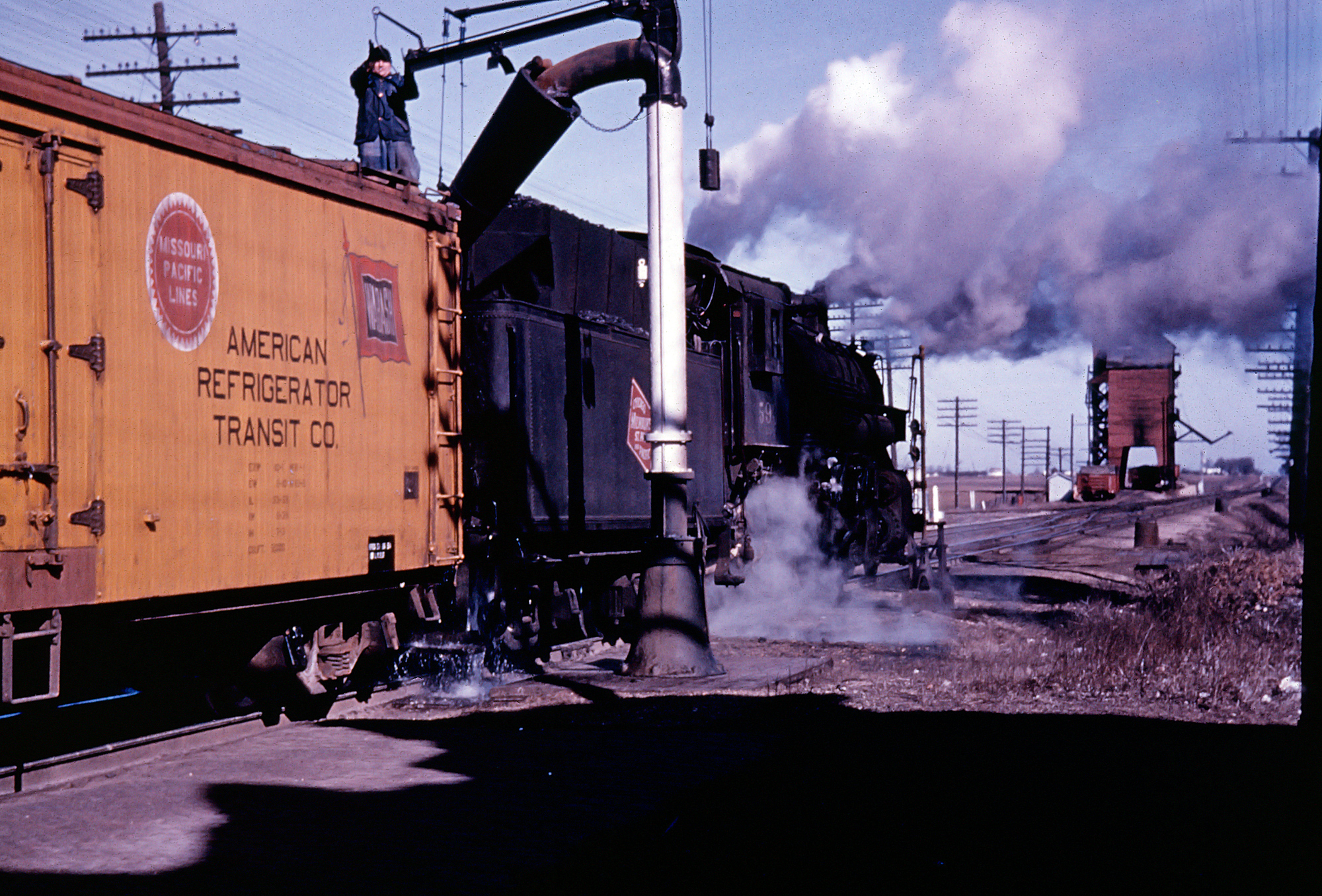The Water Standpipe: A Vital Steam Era Device
Published: July 15, 2024
By: Adam Burns
A water standpipe, often referred to by various names such as a water crane, water column, or water plug, constitutes a vital component in the infrastructure of railroading, particularly during the era of steam locomotives.
These devices ensured that engines remained adequately supplied with one of their most crucial resources: water.
Sitting regally beside many a railway track, the water standpipe plays a silent yet indispensable role in the vast network of rail transport.
 Milwaukee Road 4-6-0 #59 takes on water at Sturtevant, Wisconsin, circa 1950. A.C. Kalmbach photo. American-Rails.com collection.
Milwaukee Road 4-6-0 #59 takes on water at Sturtevant, Wisconsin, circa 1950. A.C. Kalmbach photo. American-Rails.com collection.Historical Context
In the golden age of steam locomotives, spanning the mid-19th to the mid-20th centuries, water was as pivotal to train operation as fuel.
Steam engines relied on boiling water to generate the steam that drove their pistons. A constant and reliable water supply along rail routes was thus paramount. Water standpipes, or cranes, emerged as the foremost solution to this necessity.
Design and Structure
A conventional water standpipe functioned by channeling water from an underground pipe to an elevated outlet, designed typically in a "L" shape.
The lower, vertical segment connected to the water source beneath the ground, while the upper, horizontal segment acted as the spout from which water would flow into the engine's tender.
These spouts not only had to be adjustable to accommodate varying tender heights but also rotatable to facilitate a convenient dispensing angle.
The standard setup included a large valve, often operable via a lever or wheel, allowing the crew to control the water flow.
Efficiency and ease-of-use were paramount, as the locomotive crew frequently needed to replenish water quickly to maintain timetables.
Varieties and Innovations
Over the years, several variations of water standpipes emerged, reflecting regional and operational differences. For instance:
1. **Manual Standpipes:** Operated entirely by hand, these required the crew to manually open the valve and position the spout. They were simple and economical but sometimes labor-intensive.
2. **Counterweighted Standpipes:** These incorporated a counterweight mechanism to ease the lifting of the spout into place. This innovation significantly reduced the physical effort required, enhancing efficiency.
3. **Pneumatic Standpipes:** A later innovation integrated pneumatic systems, allowing the standpipe to be operated with pressurized air. This advanced version minimized manual labor and sped up the water replenishment process.
Role in Operations
In practical terms, the water standpipe or crane ensured locomotives could complete their journeys without running dry.
Given a typical steam locomotive's water consumption—which could exceed a thousand gallons per trip—the presence of strategically placed standpipes along the railway network was indispensable.
Locomotives would plan their routes around these water stops. As the train approached a known water station, the crew prepared for a swift stop.
The fireman or another crew member would align the tender with the standpipe, operate the lever to release the water, and swiftly refill the tender's tanks. Timing and efficiency were critical; delays could cascade down the line, affecting overall train schedules.
Location and Placement
Water standpipes were typically situated at major stations, yards, designated water stops, and strategic points along key routes.
Their placement avoided congested areas to facilitate easy train access without disrupting other operations.
When positioned in yards or depots, they catered to multiple tracks, often featuring long spouts and multi-angle fittings for maximum reach.
Maintenance and Challenges
Maintaining water standpipes was as crucial as the engines they serviced. Over time, wear and tear, particularly from repeated use and exposure to the elements, necessitated routine inspections and repairs.
Leaks, rust, and blockages needed addressing to ensure uninterrupted service. During winter, freezing temperatures posed significant challenges, as frozen pipes could halt water supply. Insulating the standpipes and employing heating systems were common mitigation measures.
Legacy and Modern Transition
With the advent of diesel and electric locomotives, the necessity for water standpipes diminished. These newer trains did not rely on water for propulsion, leading to the gradual obsolescence of the standpipes.
Many were dismantled or repurposed, while some, standing as relics of a bygone era, became historical markers and points of interest for railway enthusiasts.
Present-Day Significance
Although no longer in active service, water standpipes hold tremendous historical value. Preserved examples can be found in railway museums and heritage railways, where they serve as tangible reminders of the steam age.
These artifacts help educate the public about the evolution of railway technology and operations, highlighting the ingenuity and complexity of past systems.
Moreover, heritage railways that operate steam locomotives often maintain operational water standpipes.
These operational examples provide enthusiasts and visitors a glimpse into the daily workings of steam railroading, offering experiences rich with authenticity.
Conclusion
In retrospect, the water standpipe—known variably as the water crane, column, or plug—played an indispensable role in the era of steam locomotion.
Its importance, extending beyond mere utility, symbolized the intricate choreography of railway operations.
As we move further into advanced railway technologies, these humble standpipes remind us of the era when steam ruled the rails, embodying both the spirit and the challenges of that indomitable age.
Recent Articles
-
Indiana - Whiskey - Train Rides
Dec 23, 25 06:40 PM
Whether you're a local resident or a traveler looking to explore Indiana from a unique perspective, hopping on a whiskey train ride is a journey worth considering. -
California - Wine Tasting - Train Rides
Dec 23, 25 06:33 PM
This article explores the charm, routes, and offerings of these unique wine tasting trains that traverse California’s picturesque landscapes. -
Alabama - Wine Tasting - Train Rides
Dec 23, 25 06:26 PM
While the state might not be the first to come to mind when one thinks of wine or train travel, the unique concept of wine tasting trains adds a refreshing twist to the Alabama tourism scene.



